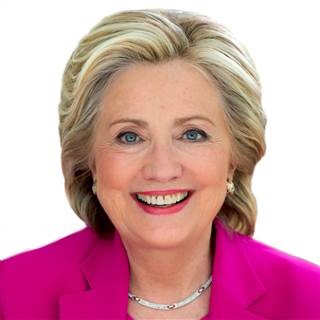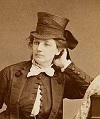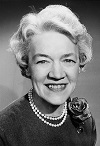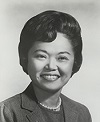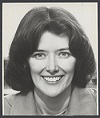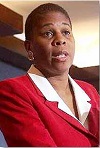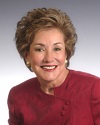Is Hillary Rodham Clinton the First Female Presidential Candidate?
Today, Oct. 26, is Hillary Rodham Clinton’s sixty ninth birthday. Clinton served as a U.S. Senator from 2001-2009; she was the first lady, married to President Bill Clinton, from 1993-2001. She first ran for president in 2008, but lost the nomination to Barack Obama. Now the 2016 Democratic candidate for president, she has attracted attention for numerous reasons including the fact that she is a female running for the office that has always been held by a male. But is she the first female to run for the office of president of the United States? In recent times two women have been nominated for vice president: Sarah Palin as the Republican candidate in 2008 and Geraldine Ferraro as the Democratic candidate in 1984. But what about presidential candidates?
In 1872 Victoria Claflin Woodhull (1838-1927) ran for president as the candidate for the Equal Rights Party. She is the first woman to run for the office. Her opposing candidates were Ulysses S. Grant, Republican candidate and former Civil War Union general, and Horace Greeley, Democratic candidate. Although she obviously lost the race, she did found her own newspaper, she fought for women’s rights and she owned a Wall Street investment firm – all impressive accomplishments for a woman in the late 19th and early 20th centuries.
Belva Ann Bennett Lockwood (1830-1917), a lawyer, ran for president twice (1884 and 1888) as the Equal Rights Party candidate. In 1884 she ran against Grover Cleveland, Democrat, and James G. Blaine, Republican. In 1888 she ran against Cleveland (Democrat) and Benjamin Harrison (Republican). Lockwood was the first woman lawyer to practice before the Supreme Court; she drafted the law which was passed by Congress enabling women to do so.
Margaret Chase Smith (1897-1995) is the first woman nominated for president by a major political party; she was a Republican candidate in 1964, but removed her name from the ballot after the first round of voting. Smith served in the House of Representatives for four terms beginning in 1940. She became a senator in 1948 and served there for four terms.
Shirley Anita Chisholm (1924-2005), the first African American woman to run for president, actively campaigning nationwide as a Democratic candidate. At the 1972 Democratic National Convention she received more than 150 delegate votes. Chisholm is the first African American woman to serve in Congress; she served from 1969 until 1968.
The same year-1972- as Chisholm ran for president, Patsy Takemoto Mink (1927-2002) ran as an anti-war candidate in the Oregon Democratic presidential primary election. Mink, a Japanese American lawyer from Hawaii, served in Congress 1965-1977 and 1990-2002.
 Ellen McCormack (1926-2011) ran for president twice, 1976 and 1980, as an anti-abortion candidate for the Democratic party. McCormack was the first female candidate to qualify for federal campaign matching funds (which she mostly used to fund anti-abortion television commercials).
Ellen McCormack (1926-2011) ran for president twice, 1976 and 1980, as an anti-abortion candidate for the Democratic party. McCormack was the first female candidate to qualify for federal campaign matching funds (which she mostly used to fund anti-abortion television commercials).
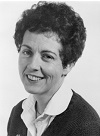 Sonia Johnson (b.1936), an English professor and a Mormon (Church of Latter Day Saints), organized “Mormons for ERA (Equal Rights Amendment)” with other women after the Mormon Church opposed the passage of the ERA. Congress had passed the ERA and sent it to state legislatures for their ratifications. The church then excommunicated her. In 1984 two political parties, the U.S. Citizens Party and the Peace and Freedom Party, nominated Johnson, making her the first third-party candidate to qualify for matching funds, but she found it difficult to get on the primary election ballots in most states and her campaign failed.
Sonia Johnson (b.1936), an English professor and a Mormon (Church of Latter Day Saints), organized “Mormons for ERA (Equal Rights Amendment)” with other women after the Mormon Church opposed the passage of the ERA. Congress had passed the ERA and sent it to state legislatures for their ratifications. The church then excommunicated her. In 1984 two political parties, the U.S. Citizens Party and the Peace and Freedom Party, nominated Johnson, making her the first third-party candidate to qualify for matching funds, but she found it difficult to get on the primary election ballots in most states and her campaign failed.
Four years later in 1988, Patricia S. Schroeder (b.1940), a Democrat and lawyer, began her campaign for the presidency. She soon dropped out of the race before the primary elections because she was unable to raise sufficient funds. Schroeder was a Congress woman; she ultimately served for twenty four years.
Lenora Fulani (b.1950), an African American born in Chester, Pa., ran for president twice, in 1988 and 1992, as the candidate of the New Alliance Party. She and the New Alliance Party were interested in ending our two-party system. In 1998 Fulani became “the first woman and the first African American to appear on the ballot in all fifty states and the District of Columbia.” Although the number of votes she received was small they were, nevertheless, the most votes received by a female presidential candidate in a general election. In 1992 Fulani ran again; this was the year that Bill Clinton won the presidential election.
Elizabeth Hanford Dole (b. 1936), with a MA in education and a law degree, was president of the American Red Cross from 1991-January 1999; she resigned to run for the Republican presidential nomination, but dropped out in October 1999. Dole campaigned for her husband, Robert Dole, during his campaign for the vice presidency in 1976 and his two attempts at the presidency, 1979 and 1987. Elizabeth Hanford Dole served three terms as the first female senator from North Carolina, 2002-2009.
 Carol Moseley Braun (b. 1947) is a lawyer who worked in the Chicago offices of the Justice Department. She is the first African American woman to be elected (1992) to the U.S. Senate from Illinois. There she was the first woman member of the Senate Finance Committee and the Judiciary Committee. Before becoming a Senator she had served in the Illinois House of Representatives. President Bill Clinton appointed her as ambassador to New Zealand, Samoa and the Cook Islands; this role ended when George W. Bush became president in 2001. In September 2003 she announced that she was running for president, but had difficulty raising campaign funds and dropped out of the race in January 2004.
Carol Moseley Braun (b. 1947) is a lawyer who worked in the Chicago offices of the Justice Department. She is the first African American woman to be elected (1992) to the U.S. Senate from Illinois. There she was the first woman member of the Senate Finance Committee and the Judiciary Committee. Before becoming a Senator she had served in the Illinois House of Representatives. President Bill Clinton appointed her as ambassador to New Zealand, Samoa and the Cook Islands; this role ended when George W. Bush became president in 2001. In September 2003 she announced that she was running for president, but had difficulty raising campaign funds and dropped out of the race in January 2004.
Michele Bachmann (b.1956) made a brief run for the presidency in 2012. A lawyer, she is a conservative activist and a founder of the Tea Party Caucus in Congress in 2010. Bachmann was elected to the Minnesota state senate in 2000; in 2006 she was elected to the U.S. Congress and became a prominent critic of President Obama. Bachmann is the first Republican Congresswoman for Minnesota. She announced her presidential candidacy in 2011, but her campaign failed to achieve the nomination. Her term in Congress ended in January 2015.
Carly Fiorina (b. 1954) is a business woman, best known for her role as the CEO of Hewlett-Packard, where in 1999 she became the first woman to head a Fortune 50 business. She was forced to resign from HP and then served in a variety of government positions. As a Republican Fiorina ran for the U.S. Senate in 2010, but lost to the Democratic candidate, Barbara Boxer. In May 2015 she announced that she would run for the 2016 presidential nomination. However, as we know, she lost.
This brings us to the current candidate for the presidency, Hillary Rodham Clinton. Clinton, a lawyer like many of the previous candidates, ran for president in 2008 and lost the nomination to Barack Obama. She is running again as the Democratic candidate; her Republican opponent is Donald Trump.
There have also been women vice presidential candidates. In addition to Sarah Palin and Geraldine Ferraro, Frances “Sissy” Farenthold, Toni Nathan and Winona LaDuke also ran for that office, but they are another story.
Dig Deeper:
“First but not the Last: Women Who Ran for President.” National Women’s History Museum online exhibit.
“Women Presidential and Vice Presidential Candidates: A Selected List.” Rutgers University CAWP Presidential Watch.
“The Women Who Ran for President.” Jo Freeman.
Dig Deeper (Individuals):
Victoria Claflin Woodhull (Falvey has many more books on Woodhull than these few listed here.)
Selected Writings of Victoria Woodhull: Suffrage, Free Love, and Eugenics. (2010). Victoria C. Woodhull.
Free Woman: The Life and Times of Victoria Woodhull. (1976). Marion Meade.
Notorious Victoria: The Life of Victoria Woodhull, Uncensored. (1998). Mary Gabriel.
Margaret Chase Smith
Margaret Chase Smith: Model Public Servant. (1998). Marlene Boyd Vallin.
No Place for a Woman: A Life of Senator Margaret Chase Smith. (2000). Janann Sherman.
Politics of Conscience: A Biography of Margaret Chase Smith. (1995). Patricia Ward Wallace.
Shirley Anita Chisholm
African-American Orators: A Bio-Critical Sourcebook. (1996).
The Columbia Documentary History of American Women Since 1941. (2003)
Patsy Takemoto Mink
Distinguished Asian Americans: A Biographical Dictionary. (1999).
Lenora Fulani
African-American Orators: A Bio-Critical Sourcebook. (1996)
Elizabeth Hanford Dole
Elizabeth Hanford Dole: Speaking from the Heart. (2004). Molly Meijer Wertheimer.
For help finding information about the other candidates, please contact our reference librarians:  Merrill.Stein – political science subject librarian or
Merrill.Stein – political science subject librarian or
CORRECTION: Merrill Stein is no longer the political science subject librarian.
 Janice Bially Mattern – political science and data services librarian
Janice Bially Mattern – political science and data services librarian
Or
Jutta Seibert, team leader – Academic Integration.
0 Comments »
No comments yet.
RSS feed for comments on this post. TrackBack URI
